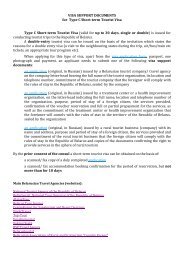Instead of having a centreof industrialized countriesand periphery of lessdeveloped countries, thereis now a more complexand dynamic environmentTABLE 2.2Different models of development partnershipscontribute to more- inclusive growth. Givencurrent trends, African consumers will continueto benefit from increased imports of affordableproducts. Flourishing local markets are likelyto breed local entrepreneurs and attract moreinvestment in extractive industries as well as ininfrastructure, telecommunications, finance,tourism and manufacturing—particularly lightmanufacturing industries in which Africancountries have latent comparative advantage. Inthis scenario, which has already begun to playout in the past decade and in other regions,host economies undergo structural change, andindigenous industry responds to competitivepressure from imports and investment inflowsby upgrading production. But the process isproving difficult in countries where technologicalcapabilities and infrastructure are less welldeveloped.Such expansion of domestic markets will behampered by substantial pockets of deprivationand lagging regions within large developingcountries. Although South Asia, for example,reduced the proportion of the population livingon less than $1.25 a day (in 2005 purchasingpower parity terms) from 61% in 1981 to36% in 2008, more than half a billion peoplethere remained extremely poor. 61These disparities undermine the sustainabilityof progress because they create social andpolitical tensions. In India, the Maoist rebelsare active in a large swathe of the country’shinterlands; in neighbouring Nepal, Maoistsevolved from an ill-equipped militia to becomethe country’s largest political party within 12years.Paris Declaration principle Traditional donors New development partnersOwnershipHarmonizationManaging for resultsMutual accountabilitySource: Adapted from Park (2011).National development strategiesoutline priorities for donorsShared arrangements to minimizeburden on recipientsRecipient-led performanceassessment practicesGreater accountability throughtargets and indicatorsNational leadership articulatesneed for specific projectsFewer bureaucratic procedures tominimize burden on recipientsFocus on delivering aid quicklyand at low costMutual respect of sovereignty;policy conditionality eschewedNew forms of cooperationMany developing countries are emerging asgrowth poles and drivers of connectivity andnew relationships, opening up opportunitiesfor less developed countries of the South tocatch up and leading to a more balanced world.Instead of having a centre of industrializedcountries and periphery of less developedcountries, there is now a more complex anddynamic environment. Countries of the Southare reshaping global rules and practices intrade, finance and intellectual property and establishingnew arrangements, institutions andpartnerships.<strong>Development</strong> assistanceThe rise of the South is influencing developmentcooperation bilaterally, regionally andglobally. Bilaterally, countries are innovatingthrough partnerships that bundle investment,trade, technology, concessional finance andtechnical assistance. Regionally, trade andmonetary arrangements are proliferating inall developing regions, and there are pioneeringefforts to deliver regional public goods.Globally, developing countries are participatingactively in multilateral forums—the G20,the Bretton Woods institutions and others—and giving impetus to reforms in global rulesand practices.A rising number of developing countriesprovide aid bilaterally and through regionaldevelopment funds. Often, this involves entwiningconventional development assistancewith trade, loans, technology sharing anddirect investments that promote economicgrowth with some degree of self-reliance.Countries of the South provide grant aid ona smaller scale than traditional donors dobut also give other forms of assistance, oftenwithout explicit conditions on economicpolicy or approaches to governance. 62 In project-basedlending, they may not always havebeen very transparent, but they do give greaterpriority to the needs identified by receivingcountries, ensuring a high degree of nationalownership (table 2.2).Brazil, China and India are importantproviders of development assistance, whichis substantial for countries in Sub-Saharan56 | HUMAN DEVELOPMENT REPORT <strong>2013</strong>
Africa. 63 Brazil has transplanted its successfulschool grant programme and its programmefor fighting illiteracy to its African partners.In 2011, it had 53 bilateral health agreementswith 22 African countries. 64 China has complementedits investment flows and trade arrangementswith finance and technical assistancefor building hard infrastructure. In July 2012,China pledged to double concessional loansto $20 billion over the next three years. 65 TheExport-Import Bank of India has extended$2.9 billion in lines of credit to Sub-SaharanAfrican countries and has pledged to providean additional $5 billion over the next fiveyears. 66 Between 2001 and 2008, countries andinstitutions from the South met 47% of officialinfrastructure financing for Sub-SaharanAfrica. 67The new development partners from theSouth follow their own model of bilateral cooperation(box 2.7). The scale of their financialassistance, combined with their approach toconditionality, can enhance policy autonomyin less developed countries. 68 Less developedcountries can now look to more emerging partnersfor development support. 69 This expandstheir choices, as foreign powers compete forinfluence, access to local consumers and favourableinvestment terms.The regional development assistancearchitecture is also evolving through theregional development banks: the African<strong>Development</strong> Bank, the Asian <strong>Development</strong>Bank and the Inter-American <strong>Development</strong>Bank. In 2009, playing a countercyclical role,the regional development banks togetherprovided 18.4% ($3.4 billion) of the aidprovided by all multilateral institutions, a42% increase over 2005. <strong>Development</strong> assistancefrom the Arab States has also made importantcontributions, reaching $6 billion in2008. 70 Some of the largest financiers of infrastructurein Sub-Saharan Africa between2001 and 2008 were regional banks andfunds based in Arab States. 71 <strong>Development</strong>assistance from regional development banksmay become more important to low-incomecountries in the coming years (as maySouth–South development assistance) ifpolicymakers in wealthy countries curtail aidcommitments because of domestic economicand political challenges. 72BOX 2.7Brazil, China and India at work in ZambiaThe model of bilateral cooperation being practiced by new development partners from theSouth has been changing rapidly. Until recently, the contribution of the new partners toZambia’s overall development finance was small. Of the total $3 billion in grants and loansthat Zambia received between 2006 and 2009, disbursements by Brazil, China and Indiamade up less than 3%.In November 2009, China and Zambia announced that China would extend a $1 billionconcessional loan, in tranches, to Zambia for the development of small and medium-sizeenterprises. This is the equivalent of 40% of Zambia’s total public external debt stock. In2010, the Export-Import Bank of China extended a $57.8 million loan to Zambia to procurenine mobile hospitals. Also in 2010, India announced a line of credit of $75 million, followedby another line of credit of $50 million, to finance a hydroelectric power project.Brazil has invested heavily in mining equipment at the Konkola Copper Mines in the Northwesternprovince of Zambia (managed by an Indian company). The large Brazilian miningcompany, Vale, is in a joint venture with the South African company Rainbow in copperprospecting and mining in Zambia, with an initial investment of about $400 million. Braziland Zambia have also signed technical cooperation agreements covering livestock andhealth.Source: HDRO; Kragelund <strong>2013</strong>.<strong>Development</strong> partners in the South have notsought to engage with or overturn the rules ofmultilateral development assistance. But theyhave indirectly introduced competitive pressuresfor traditional donors and encouragedthem to pay greater attention to the needs andconcerns of developing countries. In contrastto many traditional donors’ focus on social sectors,new partners have in recent years investedheavily in new infrastructure across low-incomecountries—resulting in, for instance, a35% improvement in electricity supply, a 10%increase in rail capacity and reduced price oftelecommunications services. 73Trade and financial agreementsAfrica, Asia and Latin America have seen anexpansion of trade agreements—bilateral,subregional and regional. In South Asia, theseregional agreements have trumped politicaldifferences. In East Africa, greater regionalintegration has helped shield economies fromglobal shocks. 74 There is scope to strengthenregional integration through practical measuressuch as streamlining transit, transportand customs procedures and harmonizingnational regulatory schemes. There is alsoscope to lower tariffs on South–South trade inThere is much scopeto strengthen regionalintegration throughpractical measures suchas streamlining transit andtransport proceduresChapter 2 A more global South | 57
- Page 1 and 2:
WNSEHuman DevelopmentReport 2013The
- Page 3 and 4:
Human Development Report 2013The Ri
- Page 5 and 6:
Human Development Report 2013 TeamD
- Page 7 and 8:
Finally, the Report also calls for
- Page 9 and 10:
Heather Simpson, Ben Slay, Mounir T
- Page 11 and 12:
3.6 India’s Supreme Court issues
- Page 13 and 14:
OverviewOne of the most heartening
- Page 15 and 16:
and sustainability are fully incorp
- Page 17 and 18: Without investment in people, retur
- Page 19 and 20: opportunity to reap the full benefi
- Page 21 and 22: Woods institutions, the United Nati
- Page 23 and 24: IntroductionWhen developed economie
- Page 25 and 26: leading economies—Brazil, China a
- Page 27 and 28: comparable access to information, e
- Page 29 and 30: mobile phones: cellular banking is
- Page 32 and 33: “The political problem ofmankind
- Page 34 and 35: BOX 1.1Fairness, macroeconomics and
- Page 36 and 37: BOX 1.3Amartya Sen, Nobel Laureate
- Page 38 and 39: FIGURE 1.1Income per capita is risi
- Page 40 and 41: BOX 1.4Subjective indicators of wel
- Page 42 and 43: FIGURE 1.4There is notable variatio
- Page 44 and 45: FIGURE 1.6Most regions show declini
- Page 46 and 47: Progress in humandevelopment achiev
- Page 48 and 49: BOX 1.7Social competencies: human d
- Page 50 and 51: TABLE 1.3Inequality and satisfactio
- Page 52 and 53: Not all countries havethe precondit
- Page 54 and 55: “When the music changes,so does t
- Page 56 and 57: BOX 2.1The South’s integration wi
- Page 58 and 59: FIGURE 2.1As a share of world merch
- Page 60 and 61: BOX 2.2Acquisitions by the South of
- Page 62 and 63: FIGURE 2.3Between 2000 and 2010, In
- Page 64 and 65: FIGURE 2.4Export earnings per capit
- Page 66 and 67: BOX 2.6Final assembly is about more
- Page 70 and 71: FIGURE 2.6Emerging market economies
- Page 72 and 73: Developing countriestrade more amon
- Page 74 and 75: “We cannot expect thatall nations
- Page 76 and 77: TABLE 3.1Selected developing countr
- Page 78 and 79: A common featureof countries thatha
- Page 80 and 81: More important thangetting prices r
- Page 82 and 83: BOX 3.5Eastern Europe and Central A
- Page 84 and 85: States have to beconscious that the
- Page 86 and 87: As countries develop,they tend to d
- Page 88 and 89: Having weathered theAsian financial
- Page 90 and 91: Providing publicservices that contr
- Page 92 and 93: Advancing health requiresmore than
- Page 94 and 95: Universal public healthand educatio
- Page 96 and 97: • China. The Minimum Livelihood G
- Page 98 and 99: “Each generation will reap whatth
- Page 100 and 101: concerns will make for a complex en
- Page 102 and 103: A greater emphasison education cans
- Page 104 and 105: FIGURE 4.1Under the fast track scen
- Page 106 and 107: Around the worldpeople are calling
- Page 108 and 109: FIGURE 4.4Different environmental s
- Page 110 and 111: FIGURE 4.5Education policies can al
- Page 112 and 113: BOX 4.2China and Ghana: who benefit
- Page 114 and 115: FIGURE 4.8countries thus converge t
- Page 116 and 117: “Let us join hands to try tocreat
- Page 118 and 119:
Areas of globalinternational concer
- Page 120 and 121:
Addressing climatechange requires t
- Page 122 and 123:
International governanceis increasi
- Page 124 and 125:
BOX 5.2Jo Leinen, Member of the Eur
- Page 126 and 127:
facilitates reserve investments and
- Page 128 and 129:
Responsible sovereigntytakes the lo
- Page 130 and 131:
FIGURE 5.1Under the accelerated pro
- Page 132 and 133:
Good policymakingrequires greater f
- Page 134 and 135:
A fair and less unequalworld requir
- Page 137 and 138:
NotesOverview1 Atsmon and others 20
- Page 139 and 140:
25 Blinder 2006.26 UNIDO 2009.27 UN
- Page 141 and 142:
which is 61.7 deaths per 1,000 live
- Page 143 and 144:
ReferencesAbdurazakov, A., A. Minsa
- Page 145 and 146:
urban_world_cities_and_the_rise_of_
- Page 147 and 148:
Kamau, P., D. McCormick, and N. Pin
- Page 149 and 150:
Labor Administration. Geneva: Inter
- Page 151 and 152:
Human Development Report 2013The Ri
- Page 153 and 154:
Statistical acknowledgementsThe Rep
- Page 155 and 156:
Key to HDI countries and ranks, 201
- Page 157 and 158:
Human Development Report 2013The Ri
- Page 159 and 160:
Human Development Report 2013The Ri
- Page 161 and 162:
Human Development Report 2013The Ri
- Page 163 and 164:
Human Development Report 2013The Ri
- Page 165 and 166:
Human Development Report 2013The Ri
- Page 167 and 168:
Human Development Report 2013The Ri
- Page 169 and 170:
Human Development Report 2013The Ri
- Page 171 and 172:
Human Development Report 2013The Ri
- Page 173 and 174:
Human Development Report 2013The Ri
- Page 175 and 176:
Human Development Report 2013The Ri
- Page 177 and 178:
Human Development Report 2013The Ri
- Page 179 and 180:
Human Development Report 2013The Ri
- Page 181 and 182:
Human Development Report 2013The Ri
- Page 183 and 184:
Human Development Report 2013The Ri
- Page 185 and 186:
Human Development Report 2013The Ri
- Page 187 and 188:
Human Development Report 2013The Ri
- Page 189 and 190:
Human Development Report 2013The Ri
- Page 191 and 192:
Human Development Report 2013The Ri
- Page 193 and 194:
Human Development Report 2013The Ri
- Page 195 and 196:
Human Development Report 2013The Ri
- Page 197 and 198:
Human Development Report 2013The Ri
- Page 199 and 200:
Human Development Report 2013The Ri
- Page 201 and 202:
Human Development Report 2013The Ri
- Page 203 and 204:
Human Development Report 2013The Ri
- Page 205 and 206:
Human Development Report 2013The Ri
- Page 207 and 208:
Human Development Report 2013The Ri
- Page 209 and 210:
Human Development Report 2013The Ri
- Page 211 and 212:
Statistical referencesADB (Asian De
- Page 213 and 214:
Core features of the model pertinen
- Page 215 and 216:
Countries and HDI ranks in 2012 and
















